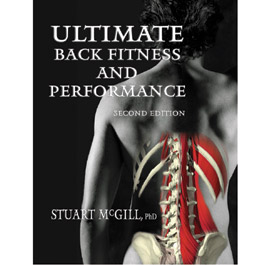Strength Training Programs and Squat Technique: To Arch or Not to Arch?
Q: I’m confused about when I should arch. I was re-reading some of your older articles, and noticed that in the Neanderthal No More series, you and Mike Robertson advocate posteriorly tilting the pelvis while performing some core exercises, yet when it comes to performing squat and deadlift technique, you encourage people to maintain the arch.
My back tightens up a lot when I arch strongly, but if I just bend over to touch my toes in flexion, it doesn’t bother me at all.
1. Could it be possible that I am arching too much during everyday movements and strength exercises?
2. What really constitutes a neutral spine? Is it different for each person?
3. When is it (if ever) appropriate to have a flat spine?
A: The main thing to consider – at least in my experience – is whether there is compressive loading on the spine. In compression, you want an arch – or at the very least, the natural curve of your lumbar spine. The discs simply don’t handle compression well when the spine is in flexion (or flat). We do more of the posterior pelvic tilt stuff when you are on your back (glute brides, as the glutes posteriorly tilt the pelvis) or on your stomach (if you arch, you’re slipping into hyperextension, which defeats the purpose of trying to resist gravity as it pushes you down to the floor).
Bending over is a LOT different than squatting and deadlifting (and comparable strength exercises). When you add load, the game changes. Cappozzo et al. found that squatting to parallel with 1.6 times body weight (what might be “average” for the typical weekend warrior) led to compressive loads of ten times body weight at L3-L4. That’s 7000N for a guy who weighs about about 150. Meanwhile, in a study of 57 Olympic lifters, Cholewicki et al. found that L4-L5 compressive loads were greater than 17,000N. It’s no wonder that retired weightlifters have reduced intervertebral disc heights under MRI! They get strong, but at a “structural price.”
According to Dr. Stuart McGill in his outstanding book, Ultimate Back Fitness and Performance, the spine doesn’t buckle until 12,000-15,000N of pressure is applied in compression (or 1,800-2,800N in shear) – so it goes without saying that we’re always playing with fire, to a degree – regardless of the strength training exercise in question, as there’s always going to be compressive loads on the spine. That’s a laboratory model, though; otherwise, the Olympic lifters above wouldn’t be able to handle much more than 12,000N without buckling. In the real world, we have active restraints – muscles and tendons – to protect our spine.
If those active restraints are going to do their job, we need to put them at a mechanical advantage – and flexion is not that advantage. The aforementioned Cappozzo et al. study demonstrated that as lumbar flexion increased under load, compressive load also increased. In other words, if you aren’t mobile enough to squat deep without hitting lumbar flexion (because the hips or ankles are stiffer than the spine), you either need need to squat a little higher or not squat at all. That said, I don’t think that you have to force a dramatic arch when you squat (or any strength exercise, for that matter); I think you need to brace your core tightly and create stability within the range of motion that you already have – and, indeed, “neutral spine” is different for everyone. For instance, females have an average of 5-7 degrees of anterior pelvic tilt, whereas males are more like 3-5 degrees – meaning that females will naturally be a bit more lordotic.
Having sufficient lumbar flexion to touch your toes with “uniform” movement through your lumbar spine is certainly important, and for most, it’ll be completely pain free (regardless of range of motion), but that doesn’t mean that a flat or flexed lumbar spine is a good position in which to exercise with compressive load.
So, to recap:
1. Neutral spine is different for everyone. What’s the same for everyone is the need to have stability within the range of motion that you’ve got.
2. Flexion is fine (and a normal functional task) when it isn’t accompanied by compressive loading. And, there is a different between subtle lumbar flexion and end-range lumbar flexion.
3. Arching (lumbar extension) doesn’t need to be excessive in order to be effective in improving tolerance to compressive loads. In most cases, that “arch” cue simply keeps a person in neutral spine as they go into hip flexion in the bottom of a squat or deadlift (or comparable strength exercise). “Arch” doesn’t mean “hyperextend;” it means to maintain the normal lordotic curve of your lumbar spine.
Looking to learn more? Check out Functional Stability Training, a comprehensive resource for assessment, programming, and coaching.
Sign-up Today for our FREE Newsletter and receive a detailed deadlift technique tutorial!





